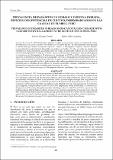Por favor, use este identificador para citar o enlazar este ítem:
https://hdl.handle.net/20.500.12958/3655Registro completo de metadatos
| Campo DC | Valor | Lengua/Idioma |
|---|---|---|
| dc.contributor.author | Guevara Torres, Mervin | - |
| dc.contributor.author | Alfaro Aguilera, Rubén | - |
| dc.date.accessioned | 2021-12-10T16:44:08Z | - |
| dc.date.available | 2021-12-10T16:44:08Z | - |
| dc.date.issued | 2021-12 | - |
| dc.identifier.citation | Guevara M, Alfaro R. 2021. Prevalencia de parásitos en robalo y corvina dorada, especies con potencial de cultivo, desembarcados en las caletas de Tumbes, Perú. Inf Inst Mar Perú. 48(4): 491-496 | es_ES |
| dc.identifier.issn | 0378-7702 | - |
| dc.identifier.uri | https://hdl.handle.net/20.500.12958/3655 | - |
| dc.description.abstract | El valor comercial a nivel nacional e internacional que tienen Centropomus nigrescens “robalo” y Micropogonias altipinnis “corvina dorada”, es una alternativa potencial para desarrollar sus cultivos en Tumbes. Por ello, se realizó un estudio para identificar su fauna parasitaria, que podría poner en riesgo los potenciales cultivos de esas especies. Se examinó 92 ejemplares de M. altipinnis y 39 de C. nigrescens, detectándose los parásitos Tagia sp. (Monogenea) y Lernanthropus sp. (Copepoda) en M. altipinnis con prevalencia de 69,57% y 4,35%, respectivamente. En C. nigrescens se determinó Lernanthropus sp. (Copepoda) y Nerocila sp. (Isopoda) con prevalencias de 66,67% y 2,56%, respectivamente. Las elevadas prevalencias de algunos de los parásitos encontrados, indican que, si estos peces fueran sometidos a cultivo, podrían desarrollar índices parasitarios intensos, siendo una amenaza potencial para la viabilidad de sus cultivos. Es necesario desarrollar estrategias sanitarias previas para el mantenimiento de poblaciones saludables bajo condiciones de cultivo. | es_ES |
| dc.description.abstract | ABSTRACT: We conducted a study to identify the parasite fauna for Centropomus nigrescens and Micropogonias altipinnis, given their high commercial value in Peru, as well as worldwide. We aimed to know if the prevalence of such parasites might endanger their crop potential in the Tumbes Region. Therefore, a total of 92 specimens of M. altipinnis and 39 specimens of C. nigrescens were examined. For the former, the following parasites were detected: Tagia sp. (Monogenea) and Lernanthropus sp. (Copepoda), with prevalence’s of 69.57% and 4.35%, respectively. While for the latter, Lernanthropus sp. (Copepoda) and Nerocila sp. (Isopoda) were detected with prevalence’s of 66.67% and 2.56%, respectively. Our findings indicate that the high prevalence of some of the parasites suggests that if these fish were cultured, they could develop intense parasitic indices, posing a potential threat to the viability of their culture. In this regard, there is a need to develop sanitary strategies for the maintenance of healthy cultured populations. | - |
| dc.language.iso | spa | es_ES |
| dc.publisher | Instituto del Mar del Perú | es_ES |
| dc.relation.ispartofseries | Informe IMARPE 48(4), 2021 | - |
| dc.rights | info:eu-repo/semantics/openAccess | es_ES |
| dc.rights.uri | https://creativecommons.org/licenses/by/4.0/ | es_ES |
| dc.source | Instituto del Mar del Perú - IMARPE | es_ES |
| dc.source.uri | Repositorio Digital IMARPE | es_ES |
| dc.subject | Centropomus nigrescens | es_ES |
| dc.subject | Robalo | es_ES |
| dc.subject | Micropogonias altipinnis | es_ES |
| dc.subject | Corvina dorado | es_ES |
| dc.subject | Parásitos | es_ES |
| dc.subject | Tagia | es_ES |
| dc.subject | Lernanthropus | es_ES |
| dc.subject | Desembarques | es_ES |
| dc.title | Prevalencia de parásitos en robalo y corvina dorada, especies con potencial de cultivo, desembarcados en las caletas de Tumbes, Perú | es_ES |
| dc.title.alternative | Prevalence of parasites in black snook and tallfin croaker with culture potential landed in the coves of Tumbes, Peru | es_ES |
| dc.type | info:eu-repo/semantics/article | es_ES |
| dc.publisher.country | Perú | es_ES |
| dc.subject.ocde | http://purl.org/pe-repo/ocde/ford#1.06.12 | es_ES |
| Aparece en las colecciones: | Informe vol. 48(4) 2021 | |
Ficheros en este ítem:
| Fichero | Descripción | Tamaño | Formato | |
|---|---|---|---|---|
| Informe 48-4 articulo1.pdf | 2,27 MB | Adobe PDF |  Visualizar/Abrir |
Este ítem está sujeto a una licencia Creative Commons Licencia Creative Commons

